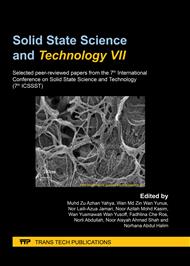[1]
J.W. Yoon, S.B. Jung, Effect of surface finish on interfacial reactions of Cu/Sn-Ag-Cu/Cu (ENIG) sandwich solder joints, J. Alloy. Compd. 448(1-2) (2008) 177-184.
DOI: 10.1016/j.jallcom.2006.10.052
Google Scholar
[2]
A. Kroupa, A. Watson, S. Mucklejohn, H. Ipser, A. Dinsdale, D. Andersson, Chapter 5 - Lead-free soldering: Environmentally friendly electronics; in, M. Singh, T. Ohji, R. Asthana (1st Edition), Green and Sustainable Manufacturing of Advanced Material, Elsevier, 2016, pp.101-134.
DOI: 10.1016/b978-0-12-411497-5.00005-9
Google Scholar
[3]
A. Roshanghias, A.H. Kokabi, Y. Miyashita, Y. Mutoh, I. Ihara, R.G. Fatt, H.R. Madaah-Hosseini, Nanoindentation creep behavior of nanocomposite Sn-Ag-Cu solders, J. Electron. Mater. 41(8) (2012) 2057-2064.
DOI: 10.1007/s11664-012-2086-6
Google Scholar
[4]
W.C. Guo, H. Xu, X.Q. Gao, X. L. Hou, Y. Li, A modified method for hardness determination from nanoindentation experiments with imperfect indenters, Adv. Mater. Sci. Eng. (2016) Article ID 9213841.
DOI: 10.1155/2016/9213841
Google Scholar
[5]
T.E. Scott, E. Kirkman, M. Haque, I.E. Gibb, P. Mahoney, J.G. Hardman, Primary blast lung injury - a review, Brit. J. Anaesth. 118(3) (2017) 311-6.
DOI: 10.1093/bja/aew385
Google Scholar
[6]
T. D. Ngo, P. Mendis, A. Gupta, J. Ramsay, Blast loading and blast effects on structures - an overview, Electron. J. Struct. Eng. 7 (2007) 76-91.
DOI: 10.56748/ejse.671
Google Scholar
[7]
W.R. Myung, Y. Kim, K.Y. Kim, S.B. Jung, Drop reliability of epoxy-contained Sn-58 wt% Bi solder joint with ENiG and ENEPIG surface finish under temperature and humidity test, J. Electron. Mater. 45(7) (2016) 3651-3658.
DOI: 10.1007/s11664-016-4517-2
Google Scholar
[8]
O.N. Ignatova, I.I. Kaganova, A.N. Malyshev, A.M. Podurets, V.A. Raevskii, V.I. Skokov, M.I. Tkachenko, G.A. Salishchev, T.N. Kon'kova, Effect of shock-wave on the internal structure and mechanical properties of fine-grained copper, Combust. Explos. Shock Waves 46 (2010) 719-723.
DOI: 10.1007/s10573-010-0096-3
Google Scholar
[9]
S.N. Kulkov, S.A. Vorozhtsov, V.F. Komarov, V.V. Promakhov, Structure, phase composition and mechanical properties of aluminium alloys produced by shock-wave compaction, Russ. Phys. J. 56(1) (2013) 85-89.
DOI: 10.1007/s11182-013-9999-2
Google Scholar
[10]
W.Y.W. Yusoff, N. Ismail, N. Safee, A. Ismail, A. Jalar, M.A. Bakar, Correlation of microstructural evolution and hardness properties of 99.0Sn-0.3Ag-0.7Cu (SAC0307) lead-free solder under blast wave condition, Solder Surf. Mt. Tech. 31(2) (2019) 102-108.
DOI: 10.1108/ssmt-06-2018-0019
Google Scholar
[11]
R. Hajek, M. Foglar, Numerical and experimental analysis of the effect of rigid barriers on blast wave propagation, J. Struct. Eng. 141(12) (2015) 588-601.
DOI: 10.1061/(asce)st.1943-541x.0001308
Google Scholar
[12]
Y. Tang, S.M. Luo, W.F. Huang, Y.C. Pan, G.Y. Li, Effects of Mn nanoparticles on tensile properties of low-Ag Sn-0.3Ag-0.7Cu-xMn solder alloys and joints, J. Alloys Compd. 719 (2017) 365-375.
DOI: 10.1016/j.jallcom.2017.05.182
Google Scholar
[13]
J. Alkorta, J.M. Martinez-Esnola, J.G. Sevillano, Critical examination of strain-rate sensitivity measurement by nanoindentation methods - application severely deformed niobium, Acta Mater. 56 (2008) 884-893.
DOI: 10.1016/j.actamat.2007.10.039
Google Scholar
[14]
M.A. Bakar, A. Jalar, A.R. Daud, R. Ismail, N.C.A. Lah, N.S. Ibrahim, Nanoindentation approach on investigating micromechanical properties of joining from green solder materials, Sains Malays. 45(8) (2016) 1275-1279.
Google Scholar
[15]
R. Rajendran, J.M. Lee, Blast loaded plates, Mat. Struct. 22 (2009) 99-127.
Google Scholar
[16]
E. Liu, T. Zhaner, S. Besold, B. Wunderle, G. Elger, Location resolved transient thermal analysis to investigate crack growth in solder joints, Microelectron. Reliab. 79 (2017) 533-546.
DOI: 10.1016/j.microrel.2017.06.014
Google Scholar
[17]
S. Zhang, P.W. Paik, A study on the failure mechanism and enhanced reliability of Sn58Bi solder anisotropic conductive film joints in a pressure cooker test due to polymer viscoelastic properties and hydroswelling, IEEE Trans. Comp. Pack. Man. 6(2) (2016) 216-223.
DOI: 10.1109/tcpmt.2015.2481458
Google Scholar
[18]
T.K. Lee, H. Ma, K.C. Liu, J. Xue, Impact of isothermal aging on long-term reliability of fine pitch ball grid array packages with Sn-Ag-Cu solder interconnects: Surface finish effects, J. Electron. Mater. 39(12) (2010) 2564-2573.
DOI: 10.1007/s11664-010-1352-8
Google Scholar
[19]
T. An, C. Fang, F. Qin, H. Li, T. Tang, P. Chen, Failure study of Sn37Pb PBGA solder joints using temperature cycling, random vibration and combined temperature cycling and random vibration tests, Microelectron. Reliab. 91 (2018) 213-226.
DOI: 10.1016/j.microrel.2018.10.003
Google Scholar


